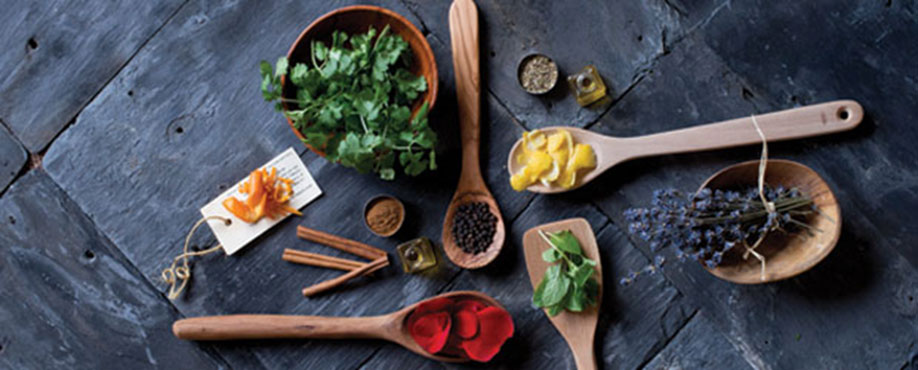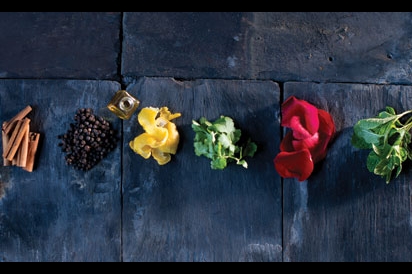How To Use Essential Oils To Heal Physical & Emotional Health
Styling by Allie Wist
Before I can finish wiping my boots on the door mat, Ruthi Bosco is whisking me away to her kitchen. Suddenly, I’m surrounded by toasted buns, meatballs, and a loaded salad with all of my favorite fixings. As the quintessential Italian mother cooks up some homemade sauce for our sandwiches, Ruthi hands me a frosty glass of iced tea. Don’t mind if I do.
After one sip, I can honestly say it is the most refreshing glass of iced tea I’ve ever tasted. It’s sweet, but not sugary. It’s bright, but not too tart. The only way to describe it is clean. “There’s Wild Orange Essential Oil in the iced tea,” Ruthi says, reading my inner monologue. “It can boost your mood, energize, and cleanse.” (Knew it!)
As an Independent Product Consultant for doTERRA Essential Oils, Ruthi has been interested in the 6,000-year-old art of aromatherapy since her high school days. “That’s kind of crazy to say that,” she says with a laugh. “I used to wear Patchouli every day to school. I just liked the smell of it, not realizing it had such calming and relaxing abilities.” Intensely studying aromatherapy, Ruthi learned the different ways these essential oils can help with physical and emotional ailments. Last year, one life-altering day, she applied a few drops of doTERRA’s Deep Blue Essential Oil Blend to her neck and says she never felt better. With 37 single oils and 19 blends available, as well as hair, skin, weight loss, and vitamin products, doTERRA has mostly everything covered.
TEACH ME
doTERRA, which means “Gift of the Earth,” is the only Certified Pure, Therapeutic Grade® essential oil company, creating the purest of products. These oils, which help defend the plants against insects and disease, are created by steam-distilling the leaves, seeds, roots, and bark, or by cold-pressing the fruits’ rinds. Ruthi likes to compare the process of oil cultivation to making wine out of grapes. “Just as grapes grown in the best climate and soil — harvested at the appropriate time — produce optimum wine, the same applies to essential oils,” she says. All plant materials are obtained from their native habitats. doTERRA’s Lavender Essential Oil (EO) is specifically from northern France, using only the organic flower heads of the plant. Lemon EO is made from the lemons of Italy and the Frankincense is from Oman, Jordan. Each EO has a multitude of uses. One particular blend, On Guard, is extremely effective in combating germs. It is a combination of five essential oils, including cinnamon, which has been tested to be 98 percent effective against all bacterial pathogens.
BREATHE IN
Since all essential oils are derived from aromatic plants, breathing them in is an effective and universal way to utilize the benefits. Five drops of essential oil and water in a diffuser circulates the scent throughout the air and can last for three hours.
They can also be used like perfume, directly on the skin. “This is called ‘neat,’” Ruthi says, as she rubs some Lime EO onto my wrist. “You can use it on your wrists, some are better on your spine, and some you put on the bottoms of your feet. Those are the largest pores.” Stronger scents, such as Cinnamon EO, should be diluted with a carrier oil before a neat application.
“The sense of smell travels directly into the limbic system, which is the part of the brain that controls memories,” she says. And just like the smell of fresh-cut grass makes us think happy, summery thoughts, certain smells can trigger different emotions in us and produce specific results. Lavender and Bergamot EOs are calming, while Lemon and Grapefruit EOs — to name a few — help elevate moods.
COOKING WITH OILS
Aside from breathing and wearing essential oils, most — excluding Cypress, Eucalyptus, and Wintergreen — can be ingested for physical and emotional benefits. Not to mention the flavor factor. One drop of Peppermint EO equals the potency of 28 cups of peppermint tea. (It is also very effective for relieving headaches!)
While getting together for lunches with two of her friends who are also Independent Product Consultants, Ruthi started adding essential oils into recipes. Thinking of creating a cookbook, Ruthi asked Lori Rothschild and Barbara Jay to help her author “Everyday Cooking with Essential Oils.”
“We put together 150 recipes using 17 different oils,” Ruthi explains. “They are recipes we made for our families, or we created them specifically for the cookbook.” The book also lists certain considerations, such as:
• Cook with glass or metal utensils and containers, not plastic.
• Drop the oils into a liquid ingredient first to disperse evenly.
• Only cook with Certified Pure, Therapeutic Grade® essential oils, such as doTERRA Essential Oils.
Ruthi’s journey from Patchouli to pure essential oils has proven to be fruitful. “I’ve always been in tune with nature, so selling these amazing oils to benefit one’s health and help people complement their business, or start businesses of their own, is a good fit for me,” Ruthi says. “It’s rewarding and a wonderful way to do business because it’s a win-win for everyone.”
For more information, contact Ruthi Bosco, 724.941.6799. doterraruthi@verizon.net. To shop for products or place an order, visit mydoterra.com/ruthibosco. To order the cookbook, visit everydaycookingwithessentialoils.com. For a free recipe excerpt, email Ruthi.
THE PSYCHOLOGY OF SCENT
Our expert, Jessie Violet Larson, LMT, with UPMC, explains how personal experiences influence our physical and emotional response to scent.
Interview by Lauren Wells
What part of the brain is responsible for allowing our sense of smell to access our emotions?
The olfactory bulb (located below the frontal lobe) is responsible for scent. Because the frontal lobe is also involved with personality, this is most likely where emotional connections to smells are formed.
How is it that certain scents evoke particular emotions? For example, why does lavender seem to have calming effects, while citrus is more energizing?
It is a common cultural belief that lavender is calming and citrus is stimulating, but some people experience the opposite. Our reactions to smell, from the time of childhood, are conditioned by personal experiences. My first encounter with lavender was in my grandmother’s house — a happy childhood memory. Citrus scents (orange juice, lemonade, etc.) are often connected to waking up or feeling refreshed. See? This is conditioning! In a recent study, a floral smell that most people described as “seductive and tropical” reminded one woman of funeral homes and lilies, causing her to feel sad and nervous. Her unique response was likely based on her own experiences.
What role do scents, like the ones found in essential oils, play in evoking memory?
As we get older, nostalgia can assign positive values to otherwise negative smells. I recently encountered a smell of creosote, wood, and fried food, and thought, “What is that? I know that smell!” Then it hit me — Kennywood Amusement Park. While those individual scents are unpleasant, together they created a nostalgic, happy response in my mind. On any given day, you may have an emotional need or memory that can be soothed by an unexpected scent. These responses are entirely based on personal experience.
Why is aromatherapy so beneficial to individuals with physical ailments?
There is a psycho-emotional state involved with illness — called a somatic response — that explains why different aromas can have varying effects on the body. In some cases, a massage paired with aromatherapy could speed up the healing process because the patient may leave the session feeling emotionally healthier or less stressed, sending a message to the brain that he or she is physically healthier. In my profession, it is a joyful experience knowing that the power of touch and scent can help patients heal, both emotionally and physically.
UPMC Center for Integrative Medicine, 580 S. Aiken Ave., Suite 310, Shadyside. 412.623.3023. upmc.com/services/integrative-medicine.
IN THIS PHOTO (left to right):
Lavender Essential Oil — Thought of as the Swiss army knife of essential oils. It is known to be calming and relaxing, and is also very effective for burns, allergies, and bee stings. // Raw element found at Roxanne’s Dried Flowers.
Cinnamon Essential Oil — Steam-distilled from the bark. It is known to fight viral and infectious diseases, can boost the immune system, and help regulate sugar levels. // Raw element found at Penzey’s Spices.
Black Pepper Essential Oil — Helpful for tobacco addiction, poor circulation, and chills. Black pepper is comforting and stimulating. // Raw element found at East End Food Co-op.
Lemon Essential Oil — Cold-pressed from the rind, and it is beneficial for depression, lymphatic cleansing, detoxing, and relieving stress. // Raw element found at East End Food Co-op.
Cilantro Essential Oil — Used for insomnia and anxiety. The herb cilantro has been used in Greece since ancient times for flavoring. // Raw element found at Lotus Food Co.
Rose Essential Oil — The queen of essential oils. It has been most widely used as an aphrodisiac, and for preventing scarring and wrinkles. // Raw element found at Whole Foods.
Peppermint Essential Oil — Extremely effective for alleviating headaches and hot flashes, and is used for aiding indigestion and freshening breath. // Raw element found at Lotus Food Co.
Wild Orange Essential Oil — Known for its energizing and revitalizing properties. Cold-pressed from the rind, this oil can help with colds, complexions, and cholesterol. // Raw element found at East End Food Co-op.






